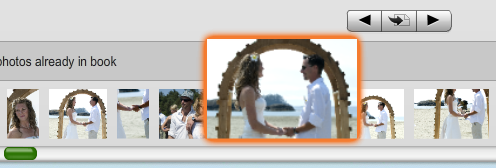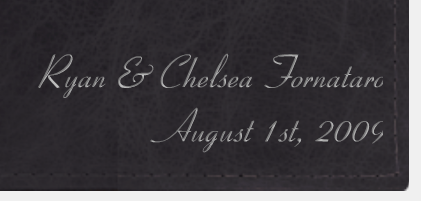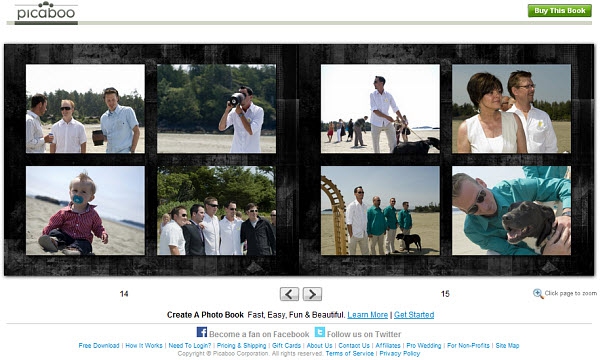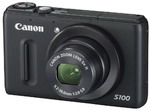Tuesday, September 28, 2010
Photo Book Luxury: Picaboo's Ranch Style Book Reviewed
Posted by Jason Dunn in "Digital Home Printing" @ 07:00 AM
The Process of Building My Book
Picaboo X is a blend of a local and online application; as you're browsing through backgrounds for instance, there's a telltale delay of an online download. This means it's ill-suited for book building when you're disconnected from the Internet and want backgrounds. On the other hand, it means they can offer thousands of backgrounds without loading them all up on the local hard drive, which is a trade-off that's worth it in my opinion.

Figure 11: As you hover over each thumbnail image, it expands to get bigger.
In terms of performance, unfortunately Picaboo X isn't a good match for the dual-core 1.6 Ghz Neo CPU on the HP dv2. I saw significant lag when clicking on buttons; quite often I'd click several times because I was unsure of whether or not the click had registered. The photo Move tool in particular reminded me of a terminal services window in which you'd type, and wait, type, and wait; I'd click an arrow to move an image, and a second later, it would move it. If I held down for too long, it would keep moving for ten seconds after I stopped clicking, forcing me to move it in the opposite direction. It was similar when adding new pages; I'd click, and 2-3 seconds later, a new page would be added. It feels like moving in slow motion. Picaboo X needs some serious CPU horsepower to work properly; it was a much nicer experience using it on my desktop computer. Not to beat a dead horse even further into the ground, but if the application were multi-threaded, performance on laptops would likely be greatly improved. If my laptop has two CPU cores, the software should use them both.
As I was using Picaboo X, I was continuing the conversation with tech support, and they informed me that in an update coming soon, they'll be using a lower resolution image in the image drag and drop process, which should dramatically improve performance on lower-end hardware. It's a start.
I jotted down some general thoughts as I built the book, so here they are:
- You can click and drag the images to resize them, but there's no snapping to fixed points on the page, which means you're eyeballing them for accuracy if you're trying to line them up with each other. Even with the grid turned on, I'm not about to guess at making two images the same size on a book this expensive. There's also no easy way to resize an image by a certain percentage or measurement; everything is done via dragging sizing handles, which is extremely imprecise.
- Picaboo X creates a project file that has all of the full-resolution images embedded in it; this makes for some large file archive sizes — my project was nearly 700 MB — but I prefer this because it means in the future I can easily edit the same book again. This is a far better approach than some of the other photo book making software out there that use virtual links, meaning if you ever move the original images, your entire book will break when you open it again (I'm looking at you, Photobook Canada).
- Because I had selected a lay-flat book, I was hoping I'd be able to create a two-page spread of a single image. Unless I'm missing something, that's not possible, which is a real shame. A two-page spread of a single image on a lay-flat book can be visually stunning.
- The software does some really clever things in the background; it "streams" the book up to the Picaboo server, uploading the images you're using as you build the book. When you go to submit your book, it only uploads the changes, greatly speeding things up. I was shocked — in a good way — at how fast my book uploaded when I had finished it. This is some brilliant programming!
- In stark contrast to the image Move tool, which is too fine-grained for my liking, the Zoom tool isn't fine-grained enough; you have to click and drag the slider, and even the slightest movement of it has a big impact on your image. It would be natural to be able to click on the Zoom icons to the left and right of the zoom slider to get precise movements, but that's not the case. It's very difficult to use this tool using a laptop trackpad; I was constantly over-shooting the zoom setting I wanted.
- Because of the expense of this book, I asked Picaboo tech support to take a look at my book and tell me if if there would be any issues with it. I was told a few of the images were a bit dark, and that I should use the brightness tool to fix the issue. I didn't have access to the original raw files, only JPEGs, and I figured a slight bump with the brightness tool inside Picaboo X would be a better solution that editing and re-compressing the JPEGs in question. The brightness tool is like using a chainsaw to trim your fingernails though; it's overkill, boosting every part of the image. It was really hard for me to see how well the tool worked, especially when I combined it with a slight bump in contrast; everything looked liked low-res mush. Ultimately, Picaboo X needs a fill light (shadow boost) tool for adjustments of dark images.

Figure 12: There was a visual bug with the text on the front cover of my book.
There was also a strange visual bug with the front cover. I had opted for the lower right-hand corner alignment for the text, but it was being cut off. Picaboo tech support informed me that the cover text is stamped by hand, so the final result wouldn't be cropped. Whew! I'd hate to order an expensive photo book like this and have the cover text not be exactly how I wanted it to be. [Cue foreshadowing music now.]

Figure 13: Here is the browser-based book sharing feature.
Before ordering the book, it's good to see how it looks. There's a preview function that renders full-resolution previews. Not surprisingly, this was nearly useless on the HP dv2 due to CPU speed, but it worked decently on my desktop PC. Picaboo also offers an online sharing function; you select your book, select how you want to share it (Facebook or Email), and when you give it an email address and a custom message, it will send an email to that person with a link to a Flash-based version of your book. It works well enough, though I'd preferred to see it scale to the browser window, so if you went full-screen it would get bigger. Right now the best you can do is click on each page and a pop-up image shows you a larger preview of that page.
I placed the order for my book on August 3rd, and received it via Fedex on August 19th.












